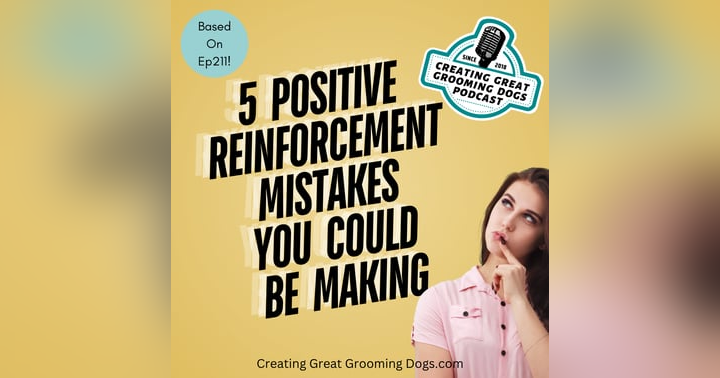5 Positive Reinforcement Mistakes You Could Be Making Ep211
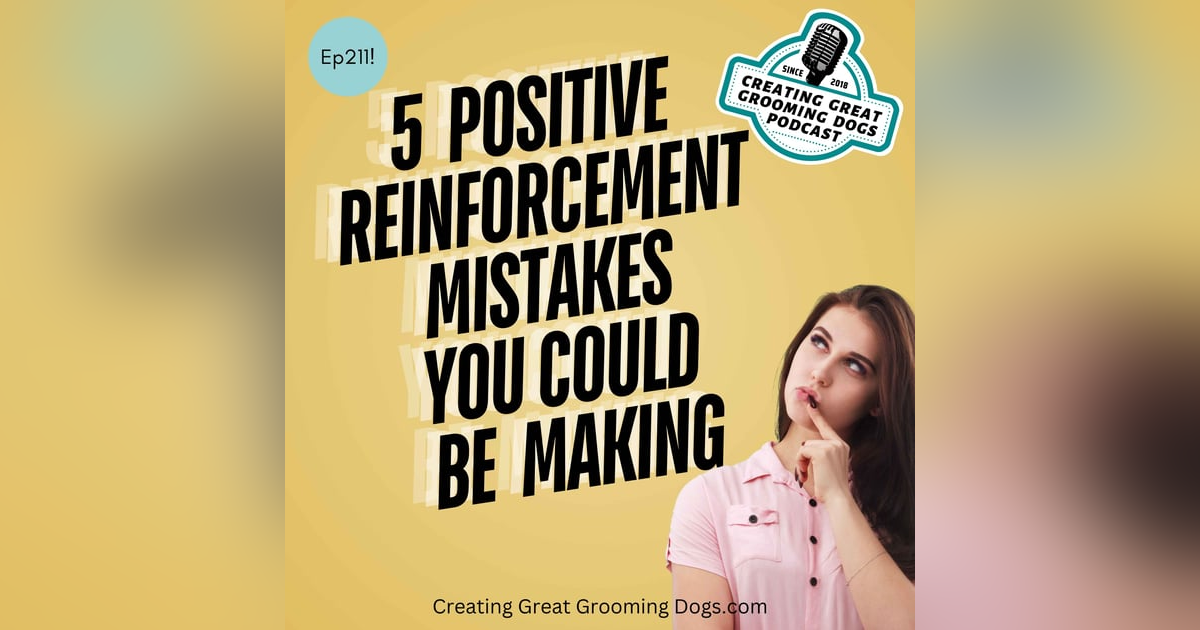
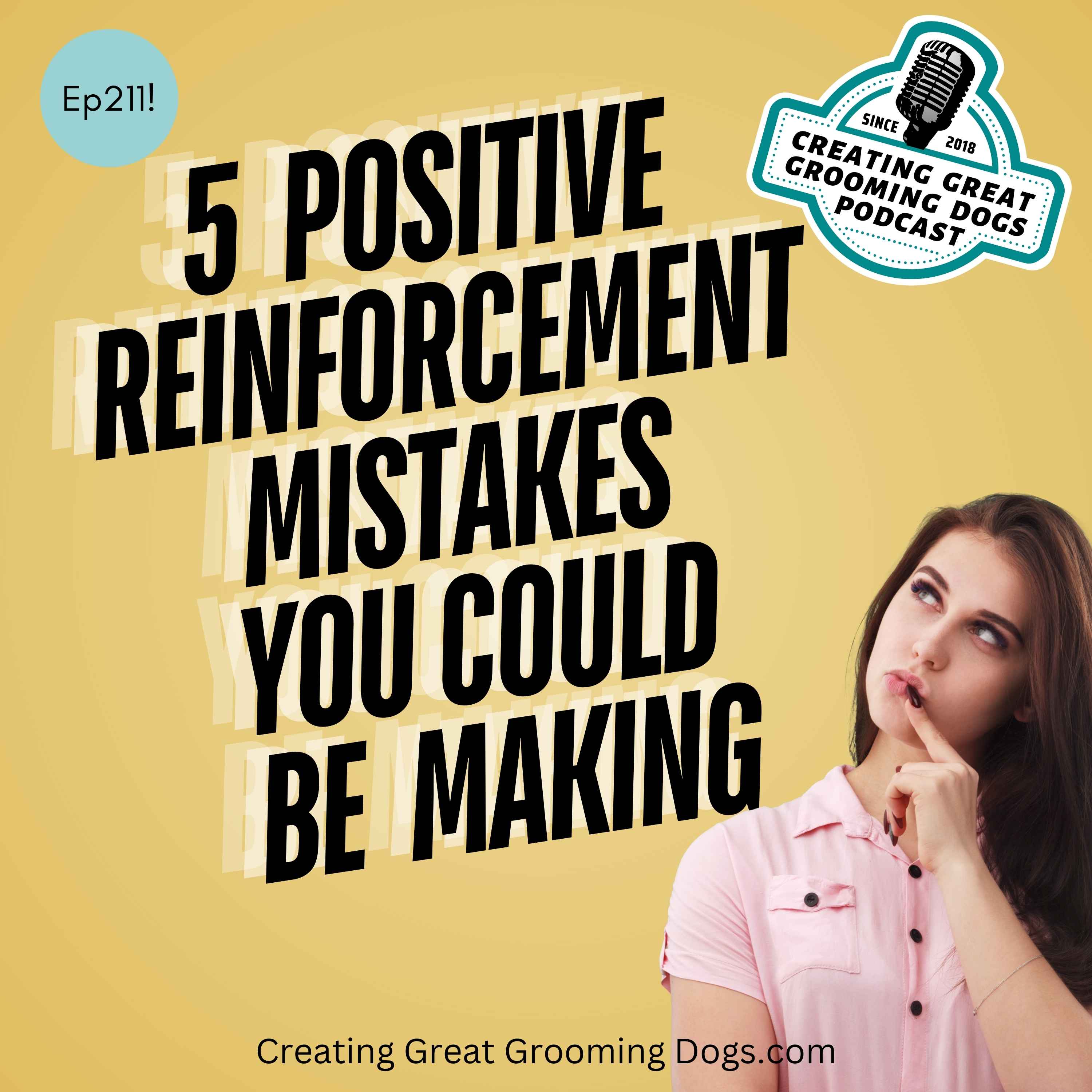
This week, we'll talk about five mistakes you could be making when you're trying to use Positive Reinforcement(+R).
For full transcripts, go to the audio episode on CreatingGreatGroomingDogs.com
For more info on all of my classes etc, go to https://link.content360.io/CreatingGreatGroomingDogs
You can also listen to this episode as a podcast on my website or anywhere you listen to podcasts.
For more information about my classes-
The full diploma program
Master Groomer Behavior Specialist(MGBS) diploma program
Shorter courses-
Modern Behavior & Handling for Groomers
Want to support the show? Buy Me A Coffee!
Ep211 5 Positive Reinforcement Mistakes You Could Be Making
Episode 211 Five Positive Reinforcement Mistakes You Could Be Making, and these are really common, so dive in with me this week. You are listening to the Creating Great Grooming Dog Show. I'm Chrissy Neumyer Smith. I'm a master groomer behavior specialist, a master canine stylist, a certified professional dog trainer, a certified behavior consultant for canines.
Uh, lots of other things. I'm the Dean of academics at the Whole Pet Grooming Academy where I teach the Master Groomer Behavior Specialist Program, and this my friends and colleagues, is the show where we talk about teaching pets to be good for grooming and other types of care. So positive reinforcement.
I think, um, I hear a lot of debates about positive reinforcement. I think that, uh, it's sometimes misunderstood. So let's jump into some of the mistakes that I find people making The first mistake, and it's, actually the first two mistakes 'cause they go hand in hand. One is thinking that every time you're using food, you're using positive reinforcement, and that is not true.
I know somebody out there just went, what? But using food means I'm using positive reinforcement, and that's not true. Positive reinforcement is a very specific, protocol. So it's different than just using food. We can use food for lots of different types of training, so. That is actually incorrect. And then it's Buddy, which is the other version of that, is that positive reinforcement doesn't mean you're using food.
So wait, I can use positive reinforcement without using food? Yes. Yes you can. So let's dig a little deeper into what positive reinforcement actually means. And I know if I had labeled this whole. Episode, like, what does positive reinforcement mean?
You guys might not have tuned in. You'd been like, I know that, and I, I feel for you, I do. , but positive reinforcement is a very specific type of procedure. It means that you see this animal doing something that you want to encourage. You actively want to encourage it, and you add something as a consequence to the behavior.
So. Basic training. Example, the dog. You say sit, the dog sits. When the dog sits, you're like, good boy. Give a cookie. Very, very common example, the dog has to do something to be rewarded. That's positive reinforcement. Positive part isn't about, it was fun or lovey-dovey. It's about adding think plus sign.
Reinforcement plus sign. The plus sign is important. That's the positive in positive reinforcement, not an emotional positive, just something added. And that's why I've been trying to convince groomers to talk about what kind of experience the dog had. I want you to start saying a pleasant experience.
We're working toward a pleasant experience. 'cause you guys are getting yourself all confused with the word positive. Oh, he had a positive experience today. Did he though? What does that even mean? , I hear lots of different versions of that. So let's save positive for the, the reinforcements and the, and the punishments and understand that the means something added.
And instead swap it out for a pleasant experience or we're working toward a pleasant experience. But positive reinforcement is something added for the purposes of encouraging a behavior. Now here's the thing, just using food, food can be used for all sorts of other things.
If you're using food to distract a dog, , I'm not real keen on using distractions unless they also know exactly what we're doing. So you can use a distraction, but don't use it to be sneaky. I don't wanna use distractions to be sneaky, but we can use a distraction if we're also telling this dog this toe. We're gonna touch this toe, or we're gonna brush your ear, or whatever it is while someone is giving them cookies. That's not positive reinforcement. That's using a distraction and it's a perfectly good use of a distraction as long as the pet still knows what we are doing.
As long as they're still aware and we're not sneaking up on 'em. That's when a lot of people say, it didn't work. 'cause you weren't using positive reinforcement. You were using food to try to be sneaky. And it backfires because nobody likes to be snuck up on like that. That's not fun.
That's not fair. . Now the other part of that, the other side of the coin, positive reinforcement can also be praise. Toys play. So sometimes groomers say, well, we're not allowed to use treats in our facility. And I understand why.
We can get into that another time. But the idea that that means that they can't use positive reinforcement is incorrect. If I have a dog who is motivated by petting and praise, then I can use that to reward behavior I liked. I don't need cookies. In fact, um, while cookies are a great, uh, they're a great training tool, right?
I mean, many, many dogs are interested in cookies. But in the grooming setting, and this is really particular for the trainers , to hear this, many of these pets are already a little bit stressed out and they are not gonna take cookies from us. And I know trainers say, well, that means they're stressed.
I'm like, don't blame the venue. , this is what we are dealing with when they're coming to us. , this is what we're dealing with in dog grooming. Many times these dogs won't take treats from us.
We can still offer treats, and I think there's some value to that. I think that, having somebody who's trying to help you be calm and trying to help you be comfortable, who also is offering you treats, I mean, it's just a gesture of goodwill. And eventually you find that maybe they do take the treat.
But I have had a, a personal pet, one of my own dogs was absolutely not interested in treats. And you may have people say, well, yeah, but it's, it's something that they need to survive. So, you know, that just means you're overfeeding and no, no, you just haven't had your dog yet who isn't interested in treats.
But praise, praise can be really useful toys. Now here's the thing. If you think that those things don't work, it could be because you have to take the individual into account here, that dog on your table, or cat or horse or cow, whatever you're working with that human, , if they don't like the thing you're giving them.
That it's not going to encourage that behavior again. So here's an example. , I see you do something awesome. And I'm like, great job. And I hand you licorice, I think that's one of those love or hate things. I like licorice. Other people think it's disgusting. So if I hand you licorice, it's going to totally change your individual perspective on did I just, , add something pleasant or unpleasant?
If I'm trying to help you do it again, and I want you to feel like, wow, that was great. I didn't know I could get something good for doing the thing, then I need to make sure that you think what I'm adding is pleasant. So praise, praise can be a great one. You don't need food to use positive reinforcement.
Praise could be good. Here's the thing though, if you don't have a bond with that pet. Your praise probably means nothing. Nothing. If I'm at the self checkout in Walmart and some random stranger says, wow, great job. I'm gonna be like, whatever. That's not gonna like increase my use of the Walmart self checkout.
It's gonna be irrelevant to my life. Maybe somebody else is like, wow, that was my highlight of my day. Or somebody else is like, oh my God, that was so socially awkward. I never wanna be in that situation again. The individual is important. What did we add that we guess we're making guesses that this individual is going to find interesting?
That's what's important. Does this individual think that what we're adding is something that they want more of? Do they want more of the treats? Do they want more of the praise? Do they want more of the petting? Do they want more of the toy? What do they want more of? And it comes after a behavior that we're actively trying to encourage, not just random treats all the time.
. There are lots of ways you could use treats, you could lure, you can distract, you can use 'em for a classical conditioning, which we can talk about another time. 'cause right now we're just talking about positive reinforcement. But there are lots of ways to use treats. Treats are just a tool.
Now, I know some groomers out there going, but I mean, they're pleasant. So doesn't that mean it's positive reinforcement(+R) ? And it does not. Positive doesn't mean pleasant. Positive means something added. In this case, reinforcement means to increase the behavior. And we'll talk more about that in the next part 'cause we've got a couple more mistakes to talk about.
If the behavior isn't increasing or staying the same, you're actually not using reinforcement. If we're trying to use positive reinforcement, something added to encourage a behavior that we liked, if we're off our mark, if we aren't quite getting it, if we're accidentally giving something that this dog dislikes and we're decreasing that behavior, it means that we have not effectively used positive reinforcement.
It's on us. We misread the dog or cat, or horse or goat, whatever you're working with. We misread the situation and what we added. It was not something that the animal would find encouraging or, and here's another one. Perhaps the animal did not make the association that that's why the thing happened, which is why sometimes we use a word like good or yes or a click of a clicker.
, there's a reason why there are things called reward markers. If an animal isn't really understanding that like, wait. Did my action cause the cookie to happen? Did my action? , wait a minute. If I sit again, will the cookie come out? Or in grooming cases, which is usually the stand, if I stand up again, what something good happened.
Some of our pets don't make that connection very well, and yet that's part of our process. So if we are going to use positive reinforcement(+R) to encourage a behavior that's on us as the trainer. In this case, even though you're a groomer or an owner, or the dog walker, whoever's listening to this, in this role right now, if you're trying to use positive reinforcement(+R) , you are in the trainer role.
And if it's not connecting for that dog, then it's on you to figure out how to help them understand that that action you just did, created my response where I now give you something, I now add something. That makes you happy and hopefully will make you want to do the thing again and again and again. , if the behavior is not increasing or staying the same, you have to adjust.
I have to figure out what is it? I'm gonna give you an example. I remember a couple times, , doing dog training classes and an owner who is doing really like big bang, bang type petting on a dog who is not finding that fun.
. Maybe their last dog really liked that, but now they have a sheltie puppy and they're petting him like he's a draft horse. And this dog, every time that hand comes down to pet him is cringing. And the owner's like I tell him, he's a good boy, Bam, Bam, Bam and, and it's the wrong good boy.
Petting action for this individual dog and is actually making him think, oh my God, I never want that to happen again. So they're actively punishing, reducing the behavior instead of increasing it because they're not responding in a way that makes this individual feel like, oh, I want that again. Ooh, I want that again.
Sometimes we're just not getting it right. Sometimes we are just missing the mark and sometimes we aren't good at guessing what an animal's gonna like. And if you're gonna add something that they like, sometimes we don't really have anything that this animal's gonna like.
Dog trainers. I need you to hear that because that's one of the things groomers struggle with when dog trainers say you need to use positive reinforcement. And we're like, honestly, this dog doesn't know us. They're coming to us at a baseline of kind of stressed out. Because they're unprepared for even meeting us, even being in our waiting room, they aren't interested in treats, they aren't interested in our praise, they're not interested in our play.
We really don't have anything to add in a lot of these cases, and that's not on us as groomers. That's us being able to say, all right, well, if I can't use positive reinforcement, there are other things in my toolkit that I need to know, and that's part of why I do the show. That's part of why I teach. But right now, just thinking if I thought using treats meant positive reinforcement, then I might be thinking that positive reinforcement is failing and it's not.
It's just that, that process might not be motivating for this dog. Positive Reinforcement(+R) works. If you have something that motivates the pet, it works. It's a pretty good protocol to use and it's motivating and it's fun, but if we don't have anything that motivates them, then we have to switch to a different tool.
And that just, I think, like I said, people just think using food means that they're using positive reinforcement and that is not true. Here is another one. How do you use positive reinforcement with a dog who isn't good for grooming? A lot of our owners are coming from a point of view that, they think that we're going to work the dog to the point where the dog is actively growling at us.
Or snarling or air snapping and then try to add cookies, and that's not gonna work. That's not the process. That's not what we're even talking about here. We need a way to help our owners understand that part. Our goal is to help this dog stay calm, comfortable, and cooperative. And within that framework, it might be that we are not getting much grooming done.
Yep. I know somebody out there who's new to the show is probably like, wait, what? Our goal is to groom. We don't sell haircuts. We sell haircutting services and in this case we have to, if an animal is really uncomfortable with grooming, we have to sell some training services, some behavior services to get them ready for grooming services.
We're not gonna push 'em to the point where they break. We're not gonna push them to the point where they're flailing around. You know, when people say, Chrissy, I need to see some video. Like, what do you do when the dog is flailing and screaming?
I'm like, I never let them get to that point. That's not training. That's not what we do. , we don't let him get to that point. So we tell our owners we're gonna work with them at the point that he can handle.
Find his comfort zone and expand it out. Teach him to trust us, teach him to like it, teach him to be good and we can use positive reinforcement(+R) , something added that's positive. The plus sign something added to increase the behavior, to increase or maintain a behavior that we like. But we have to work at a point where we're seeing behaviors that we like.
And that's why a lot of people start to think, well, I've tried positive reinforcement, it didn't work. Because they don't understand the structure of positive reinforcement(+R) , something added to increased behavior. We have to see a behavior. We like something that we want more of, and then add something the animal finds motivating.
So. What were the five mistakes? Again, the number one mistake. Using food does not mean that you're using positive reinforcement. Food is a tool that gets used in a lot of ways. The second one, using positive reinforcement doesn't mean you're using food. You can use positive reinforcement. Something added could be a toy, something added could be praise.
Something added could be playing. Positive reinforcement does not mean using food. That's the second one. The third one, the pet has to like the thing that you add, that thing that you add, whether it's food or praise or toys or play, they have to like that and want more of it.
And that's guesswork. And a lot of cases that's guesswork. Number four, is if the behavior isn't increasing or staying the same. You're not using positive reinforcement. It's a guess about what the learner is gonna want more of. And maybe it's time to stop and reassess. Is the animal just not getting it?
Do I need a reward marker? Do I need a different type of reward to add? Do I need to pick another type of tool? Because right now I don't have anything I can add that this pet wants. And the fifth one is that you can't use positive reinforcement if a dog is being bad. We need to work at a point where the dog is showing us stuff that we like.
So yeah, you don't use positive reinforcement(+R) while they're flailing around and screaming. But also don't let 'em get to the point where they're flailing around and screaming. That should not be happening in dog grooming. If an animal is behaving in such a way that they're being really aggressive. Yeah. That's not when you use positive reinforcement, but also we don't let them get that far in dog grooming. We should not be. Um, I know that's one of my very few times that I'm gonna be really opinionated, always and never, but no, we should never be letting them get that bad.
It's gonna happen once in a while. Maybe we didn't know about a particular area of their body that might be sore or something, but that should not be the norm. Just backtrack outta that and go, yeah. Right. Yeah. You don't use positive reinforcement that way, but then you also don't let them get like that during dog grooming.
So those are some of the mistakes that I find people are making with positive reinforcement(+R) . They think that, all food use means that they're using positive reinforcement and it didn't work. Food is a tool, , it's not gonna magically make dogs do things that you want them to do,
it's just a tool. There are lots of ways to use food, so keep in mind that, it's a particular process. Every time you see positive reinforcement(+R), I want you to see a plus sign. Something added.
That's what positive means.
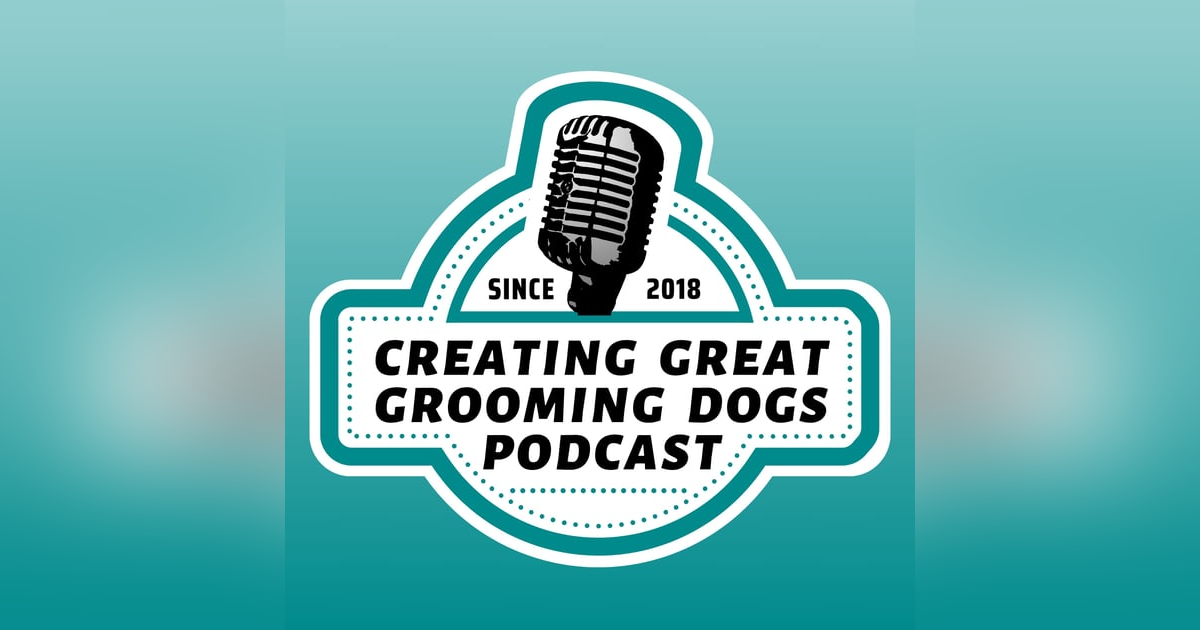


























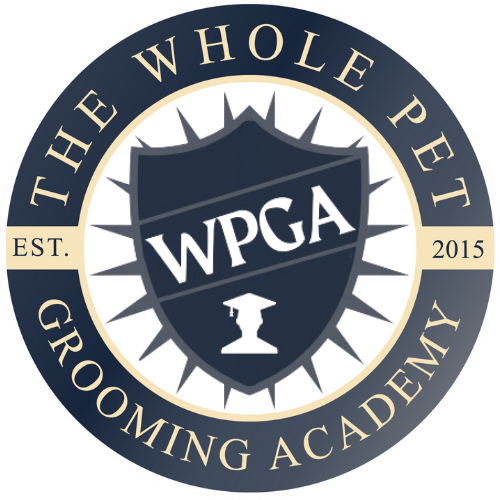 My Classes
My Classes
